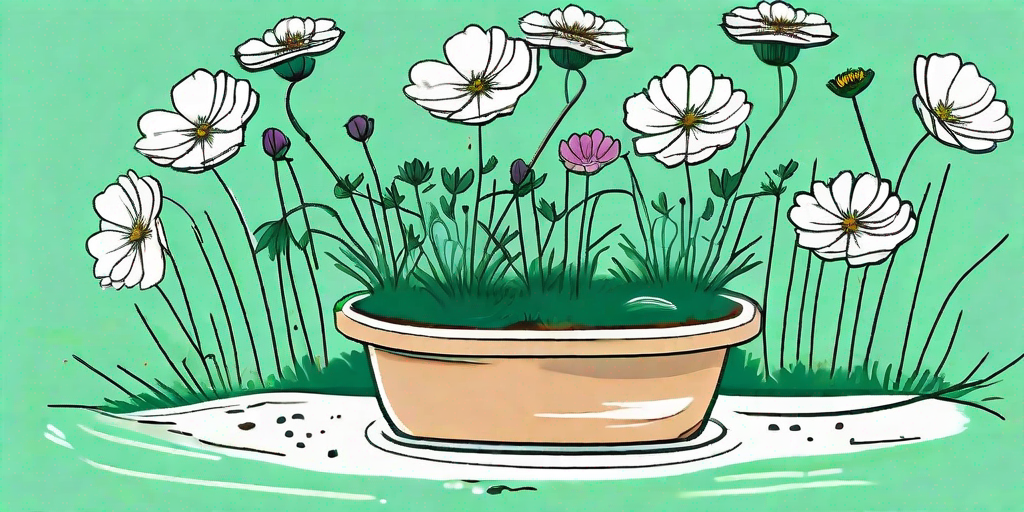
Gardening, much like life, is a constant cycle of birth, growth, and rebirth. Today, we're going to delve into the world of Cosmos, a flower that not only adds a splash of color to your garden but also embodies this cycle in a beautiful way. So, grab your gardening gloves, your sense of humor, and let's get down and dirty with Cosmos seeds!
The Cosmos: A Brief Introduction
Before we dive into the nitty-gritty of planting and harvesting, let's take a moment to appreciate the Cosmos in all its glory. Named after the Greek word for 'orderly', this flower is anything but! With its wild, daisy-like flowers and feathery foliage, the Cosmos is a rebel in the plant world, refusing to be tamed.
Native to Mexico and the southern United States, Cosmos are annual plants that come in a variety of vibrant colors, including white, pink, orange, yellow, and red. They are known for their resilience and can thrive in a variety of soil conditions, making them a favorite among novice and expert gardeners alike.
Harvesting Cosmos Seeds: A Step-by-Step Guide
Step 1: Timing is Everything
As with most things in life, timing is crucial when it comes to harvesting Cosmos seeds. The best time to harvest is when the flowers have faded and the seed pods have dried out. This typically happens in late summer or early fall, depending on your climate.
But how do you know when the seeds are ready? Well, the seed pods will turn a brownish color and become brittle. If you shake the pod, you should hear a rattling sound - that's your cue!
Step 2: The Harvest
Now that you've identified the ripe seed pods, it's time to get harvesting! Simply snip off the pods and place them in a paper bag. Be sure to label the bag with the date and type of seeds, unless you enjoy the thrill of mystery plants sprouting in your garden.
Once you've collected all the ripe pods, spread them out on a flat surface and let them dry for a few days. This will make it easier to separate the seeds from the pods.
Step 3: Separating the Seeds
After the pods have dried, it's time to separate the seeds. This can be a bit messy, so I recommend doing this over a large bowl or tray. Simply break open the pods and shake out the seeds. Don't worry if some of the pod fragments get mixed in - they won't harm your future plants.
Once you've separated the seeds, store them in a cool, dry place until you're ready to plant them. A paper envelope works well for this, but feel free to get creative with your storage solutions!
Planting Cosmos Seeds: A Step-by-Step Guide
Step 1: Preparing the Soil
As I mentioned earlier, Cosmos are not picky when it comes to soil conditions. However, they do prefer a well-draining soil, so if your garden is more clay than sand, you might want to add some compost or peat moss to improve the drainage.
Before planting, loosen the soil with a garden fork or tiller to a depth of about 12 inches. This will make it easier for the roots to establish themselves.
Step 2: Planting the Seeds
Now comes the fun part - planting the seeds! Simply scatter the seeds over the soil and lightly cover them with about 1/4 inch of soil. Cosmos seeds need light to germinate, so don't bury them too deep.
Water the area thoroughly after planting, and keep the soil moist until the seeds germinate. This usually takes about 7-14 days, so be patient!
Step 3: Caring for Your Cosmos
Once your Cosmos plants have sprouted, they require minimal care. Water them regularly, but be careful not to overwater, as this can lead to root rot. A layer of mulch can help retain moisture and suppress weeds.
Cosmos are pretty self-sufficient, but they do appreciate a little TLC. Regularly deadheading, or removing faded flowers, will encourage more blooms. And while Cosmos don't require fertilizing, a light application of a balanced fertilizer can promote vigorous growth.
FAQs
Can I plant Cosmos seeds in a pot?
Absolutely! Cosmos are great for container gardening. Just make sure your pot has good drainage and is large enough to accommodate the mature plant.
Do Cosmos attract bees?
Yes, Cosmos are a bee's best friend! Their bright colors and nectar-rich flowers are a magnet for bees and other pollinators.
Can I grow Cosmos indoors?
While Cosmos prefer the great outdoors, they can be grown indoors with the right conditions. They need plenty of sunlight, so place them near a south-facing window if possible.
Conclusion
There you have it, folks! A comprehensive guide to harvesting and growing Cosmos seeds. With a little patience and care, you too can have a garden bursting with these vibrant, resilient flowers. So what are you waiting for? Get out there and start planting the future!















